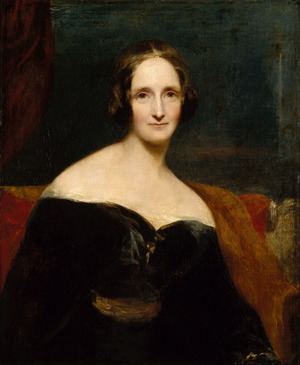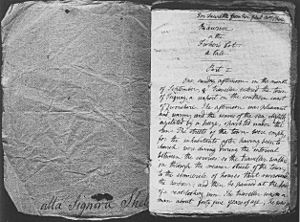Maurice (Shelley) facts for kids
Maurice, or the Fisher's Cot is a children's story written by Mary Shelley. She was a famous writer from the Romantic period. Mary Shelley wrote it in 1820 for a young girl named Laurette Tighe. Laurette was the daughter of Mary's friends, Margaret King and George William Tighe. Mary tried to get her father, William Godwin, to publish the story, but he said no. The story was then lost for a long time. It was finally found in Italy in 1997.
"Maurice" is about a boy who is looking for a home. He meets a traveler who turns out to be his father, who he thought was lost. The story has a sad feeling and shows different points of view. It focuses on the idea of loss, especially when parents and children are separated. Mary Shelley wrote about this topic in other works too, like her novel Mathilda and her play Proserpine. The simple language in "Maurice" is like the writing style of the Romantic poet William Wordsworth. Mary Shelley was reading his poems when she wrote "Maurice".
Contents
How the Story Came to Be
In 1814, when she was seventeen, Mary Shelley (then Mary Godwin) left England with Percy Bysshe Shelley. Her stepsister, Claire Clairmont, went with them. They traveled for six weeks before returning to England. Mary became pregnant with Percy's child, but the baby died soon after birth.
In 1816, Mary and Percy had another child, William. That same year, Claire Clairmont had a daughter named Allegra with the poet Lord Byron. The group spent time with Byron in 1817 at Lake Geneva. There, Mary Shelley wrote her famous book Frankenstein. Later that year, Percy and Mary got married. In September 1817, they had another child, Clara.
The group traveled to Italy in early 1818. Baby Clara Shelley became very sick during the journey. She sadly died shortly after they arrived in Venice. Mary Shelley had now lost three of her children. This made her very sad and depressed.
In 1819, the group moved to Rome. There, Mary and Percy Shelley's son William also died. Mary became pregnant again with Percy Florence. The group then traveled to Pisa and Florence. On their journey, they met a kind couple who became their friends: Lady Mountcashell and George William Tighe. Lady Mountcashell was once a student of Mary Shelley's mother, Mary Wollstonecraft.
Lady Mountcashell and George William Tighe had two daughters, Anna Laura Georgiana (called Laurette) and Nerina. Laurette and Nerina quickly became close to Mary and Claire. Mary Shelley wrote to Lady Mountcashell, saying how much she liked Laurette's "simplicity and frankness."
In early 1820, the group moved to Pisa. Claire became like an older sister to Laurette. They went to operas and the Carnival together. Later that summer, Mary Shelley began writing her historical novel Valperga.
Writing and Publishing the Story

Mary Shelley wrote "Maurice" for Laurette Tighe on August 10, 1820. Her journal for that day says: "Thursday 10—Write a story for Laurette." This story might have been a birthday gift for Laurette.
Shelley suggested that her father, the philosopher William Godwin, publish "Maurice." She thought it could be part of his Juvenile Library series. However, he said no. He might have thought the story was too short. Or perhaps it was too similar to another story he had just published. Some experts also think Godwin might have refused because the story had "strong biographical parallels." This means it was very similar to the real lives of the Shelley and Godwin families.
The original handwritten story was lost for many years. Then, in the summer of 1997, a woman named Cristina Dazzi found it. She was looking through old papers in the Dazzi family home in San Marcello Pistoiese, Italy. She was searching for something interesting for an exhibit.
Parts of the story were first published in an Italian book in 1997. One year later, Claire Tomalin, who wrote about Percy Shelley and Mary Wollstonecraft, published the entire story. She included a long introduction and a typed version of the manuscript.
What Happens in the Story
The story of "Maurice" is divided into three parts.
Part I
A traveler arrives in Torquay, Devonshire. He sees a funeral procession and notices a handsome, sad young boy in it. The traveler goes to a local inn. There, a countryman tells him about Maurice and Old Barnet, the fisherman who just died. Old Barnet was married to Dame Barnet, but she had died a year earlier. Old Barnet was very sad without his wife.
One day, Maurice appeared and offered to help Old Barnet around his house while he was fishing. Maurice was poor and often sick, so he couldn't do hard jobs. But he was very hardworking. Old Barnet grew to love Maurice, and so did the other villagers.
Part II
Old Barnet's brother tells Maurice that he must leave the cottage in one week. Maurice spends his days feeling sad about the fisherman. One day, the traveler returns to the village and looks for Maurice. He stops at the cottage and asks to stay the night.
The traveler and Maurice talk. Maurice tells him he plans to leave the cottage and find work on a farm. He also talks about his poor family. He says he doesn't want to be a burden to them. Maurice reveals that his father used to hit him because he didn't believe Maurice was truly sick. The traveler and Maurice sit together, enjoying nature. They talk about how nice country life is and the joy of reading. The traveler then offers to take care of Maurice and give him an education.
Part III
The traveler explains that he is the son of an Oxford mathematics professor. When he was young, he loved to read outside and wanted to understand how the world worked. He became an architect and traveled all over Europe. Eventually, he married a lovely woman, and they had a son named Henry.
One day, the couple left their son with his nurse while they went out. The nurse fell asleep. When they returned, their son was gone, and they couldn't find him anywhere. The traveler spent years searching the countryside for his son. One day, he met a woman named Dame Smithson. She admitted that she had stolen his son. She had lied to her sailor husband, saying she was pregnant because he wanted a child. Before he returned, she needed a baby, so she stole the traveler's son.
The child was not used to the hard life of a peasant, so he suffered and became sickly. Because of this, the woman's husband disliked him and hit him, thinking he was worthless. Hearing this story, Maurice realizes he is the traveler's son! He had changed his name to avoid the person he thought was his cruel father.
The traveler is overjoyed to be reunited with his son. He buys the cottage for Maurice, and they visit it sometimes. Maurice gets an education and grows up to travel widely. He returns later to find the cottage has fallen apart. He builds a new one for another poor fisherman's family, right next to where the old one used to be.
Images for kids
-
William "Willmouse" Shelley, painted just before his death from malaria (Amelia Curran, 1819)
See also
 In Spanish: Maurice (Shelley) para niños
In Spanish: Maurice (Shelley) para niños




